We may receive a commission when you use our affiliate links. However, this does not impact our recommendations.
 Five different types of protection exist. Here’s a guide to choosing the best one for your project.
Five different types of protection exist. Here’s a guide to choosing the best one for your project.
The need to protect wood outdoors is much greater than the need to protect it indoors because of exposure to sunlight and rain. These cause wood to gray, split, warp and rot; and moist conditions make the growth of mildew possible.
You can use paint, stain, clear finish, water repellent and preservative to prevent or retard damage to exterior wood. But first, it’s helpful to understand the causes of the damage.
Exterior Damage
Sunlight contains strong ultraviolet light, which is very destructive to wood over time. UV light destroys the lignin that glues the cellulose wood cells together, and rain then washes the lignin away. Because the lignin contains the extractives that give wood its distinctive coloring, the wood turns silvery gray on the surface when the lignin is gone.
Sunlight also heats the surface of the wood and draws out moisture, causing shrinkage. This leads to splitting and warping, and these are made worse by rain when it comes in contact with only one side of the wood – as on decks, tabletops and exterior doors. The water makes the surface cells swell, but the thickness of the wood prevents the surface from expanding. The cells are then forced to compress to oval shapes, and they hold these shapes even when dry.
This phenomenon is called “compression shrinkage” or “compression set,” and I described it in the context of finishing both sides of wood in the October 2004 issue. (Back issues are available online at popwood.com.) Compression shrinkage causes wood to warp and split as the exposed side continues to shrink a little more each time it goes through the wetting and drying cycle.
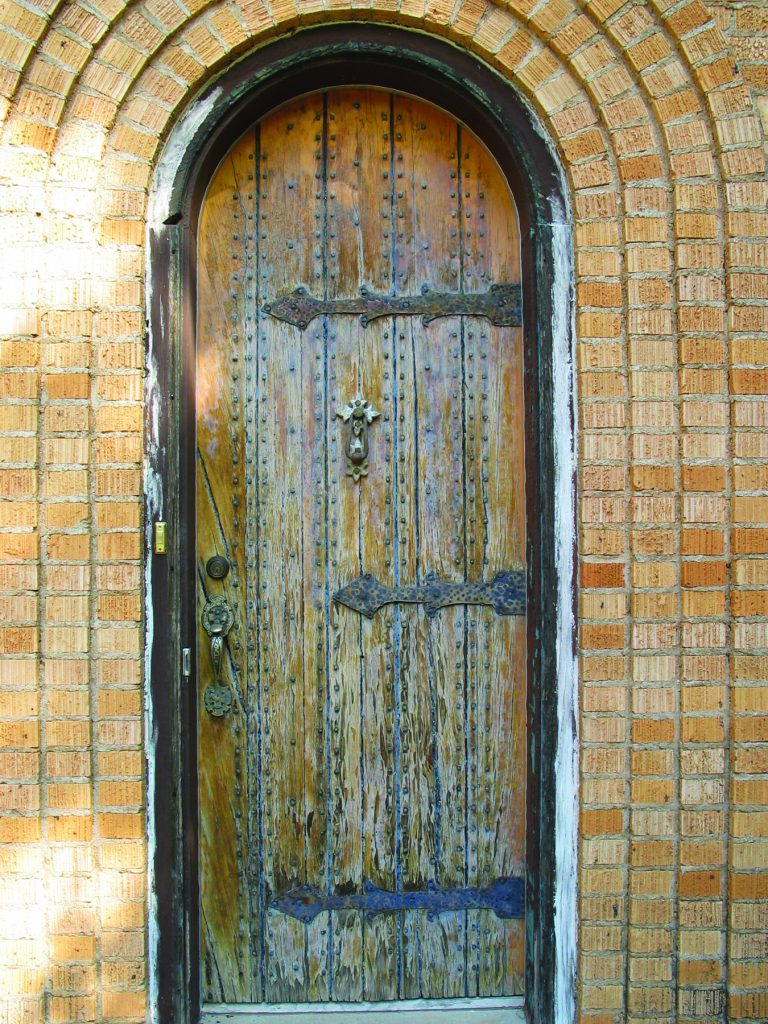
This front door faces west with no trees or other obstructions to block afternoon sunlight. You can see that the door is in good shape at the top where the deep recess in the framing protects it. But the condition worsens progressively from there down because of contact with both sunlight and rain. An overhang would offer the best protection, but this would change the design and the architect’s intent. To preserve the design, the best solution is to coat the door with a marine varnish high in UV-absorber content, and sand back and recoat whenever the varnish begins to dull.
Rain is partially responsible for rotting and the growth of mildew, because both require moisture to occur. Rain is also indirectly responsible for a visually similar damage – insect infestation – because insects require moisture to thrive.
The heartwood of redwood, cedar and some hardwoods is naturally resistant to rotting. Some softwoods are pressure treated with chemicals to make them resistant to rotting. These woods have the familiar dull green or dull brown coloring. Sapwood and non-pressure-treated pine and fir are not resistant to rotting.
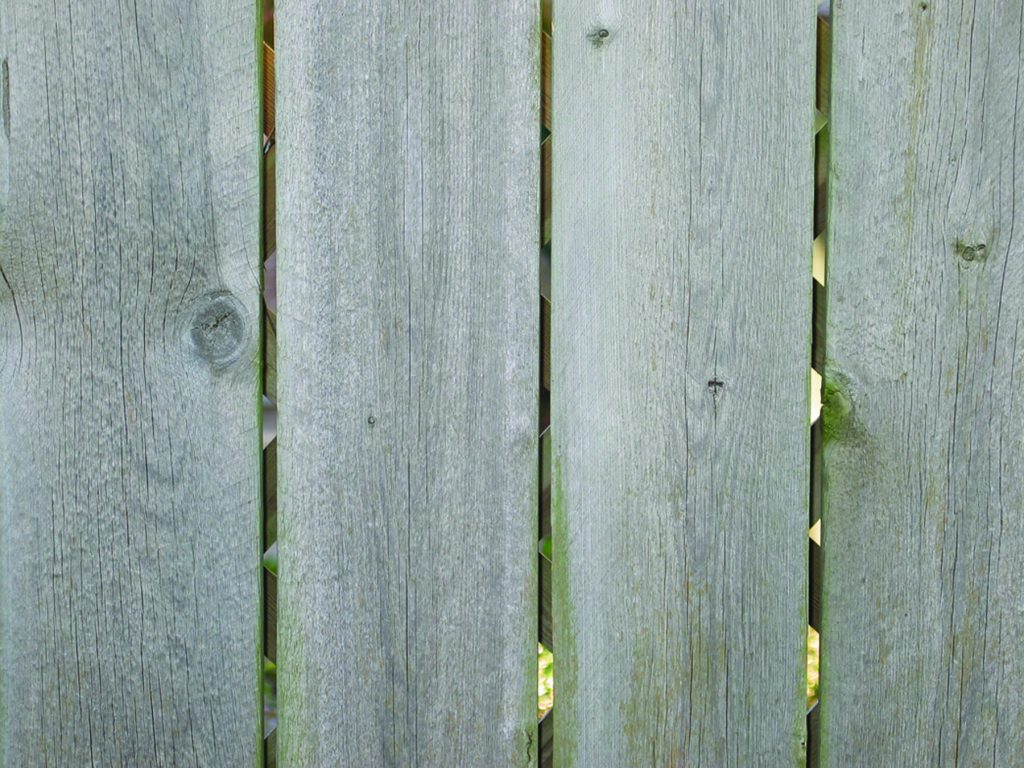
The combination of sunlight and rain causes wood to turn silvery gray. If you like the gray color, and you aren’t having other problems, you can leave the wood unprotected. The grayed surface is very effective at blocking further degradation below. UV light erodes wood at only about 1⁄4″ per century.
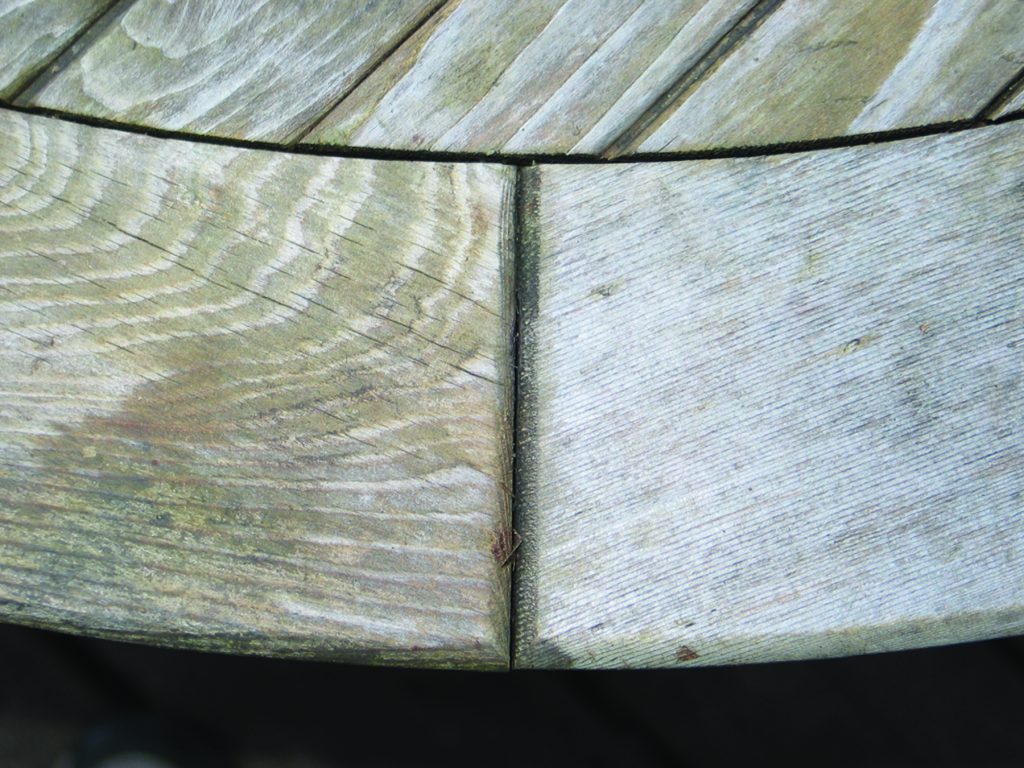
Quartersawn wood (right) is much more resistant to splitting than plainsawn wood (left). If you have a choice, always use quartersawn wood in exterior exposures. The two boards shown here are from a cedar tabletop left outside and unfinished for about eight years.
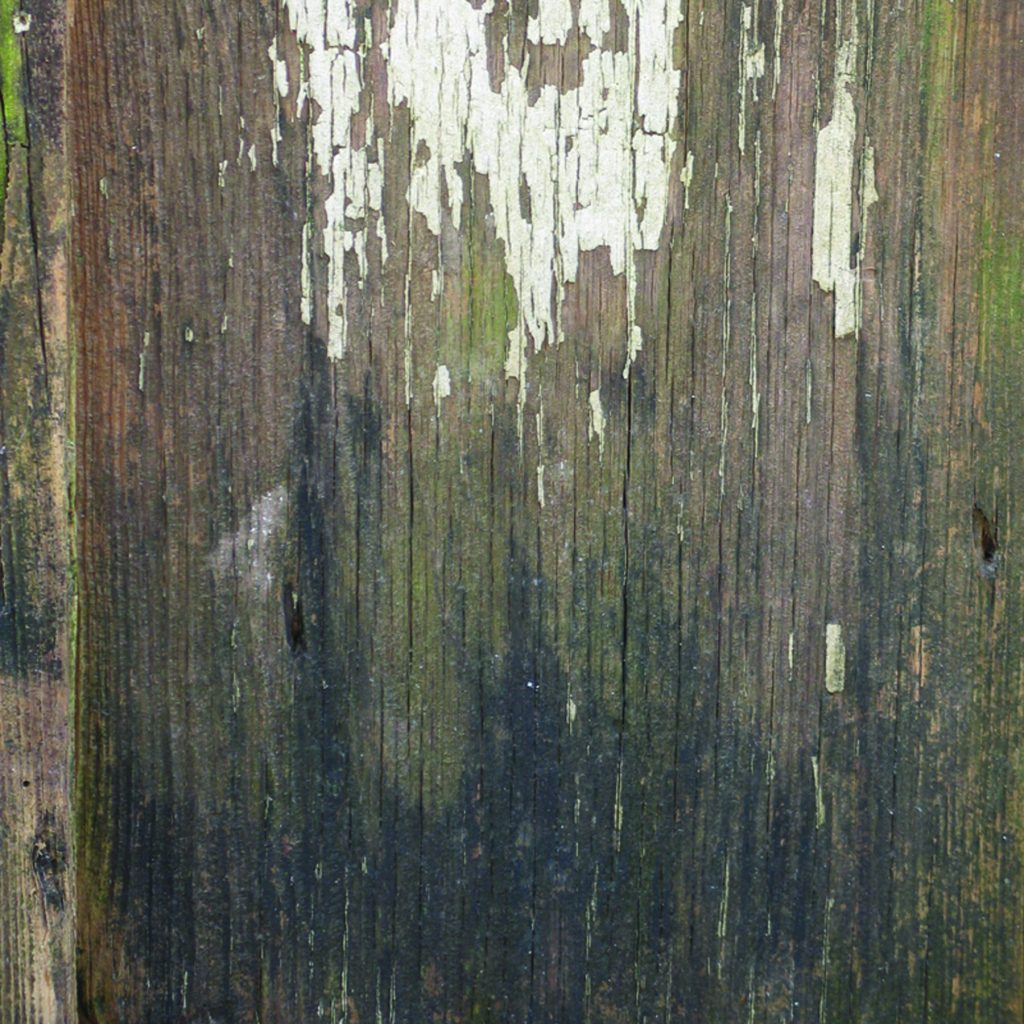
The mildew on the lower part of this board is a dark fungus that develops in moist conditions, especially in sheltered areas away from sunlight. You can prevent mildew by applying a wood preservative or a coating that contains a preservative. You can remove mildew by power washing or applying household bleach diluted with two to four parts water. Mildew causes little harm to the wood, but it looks bad.
There are five different types of coatings you can use to protect against the problems caused by sunlight and rain: paint, stain, clear finish, water repellent and preservative. You can buy any of the first four types of coatings with a preservative included to retard mildew, or you can sometimes buy a concentrated preservative separately and then add it yourself.
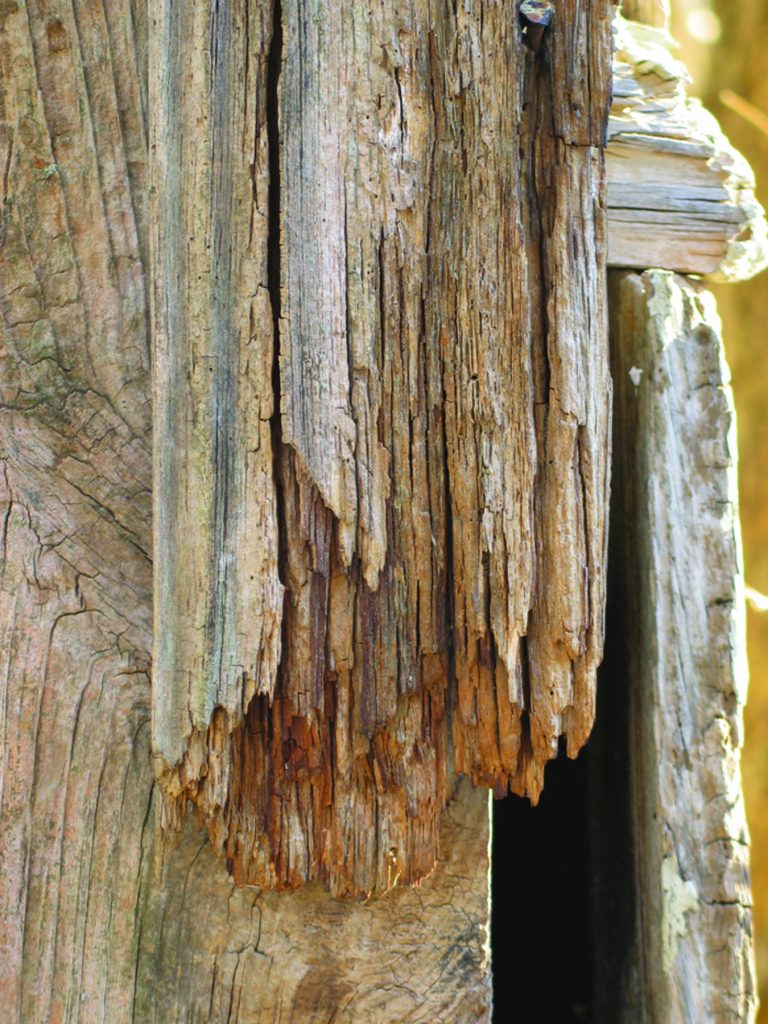
Paint
Paint is the most effective coating for protecting wood. The thick film blocks water penetration and the pigment blocks UV light. You can find wood siding that is in perfect shape after 200 years because it has been protected continuously with well-maintained coats of paint.
There are two large categories of paint: oil-based and water-based (latex). Because oil-based paint wears better than latex paint, it is best for objects that see a lot of abuse such as chairs and picnic tables.
Oil-based primers are also best when you are painting wood that has been exposed to the weather for a month or longer, especially if the wood has grayed. Oil-based primers penetrate deeper than latex primers, so they are better able to penetrate the degraded wood caused by the destruction of the surface lignin and bond to good wood underneath. If the wood is freshly milled or sanded, acrylic-latex primers perform well.
Latex paint is best for wood siding because it is better than oil paint at allowing moisture vapor created inside a building to pass through. If the moisture vapor can’t get through the paint layer, it builds up behind the paint and causes it to peel. (A primer coat of oil-based paint applied under latex paint is not thick enough to stop moisture penetration.)
Paint is great for siding and house trim because they can be caulked to keep water from getting into the wood and causing the paint to peel. Paint is also great for furniture and exterior doors if they don’t get a lot of exposure to moisture.
But paint is a poor choice for decks and often for fences because it’s rarely possible to seal off all the end grain effectively. The paint peels and requires too much work to effectively keep up.
Pigmented Stain
Pigmented stain is the next most effective coating for exterior wood. Just as with paint, it resists both moisture and UV-light damage because it contains both binder and pigment. But because there is much less of each and little or no film build, pigmented stains are not as resistant as paint.
On the other hand, the lack of film build makes maintenance easier. Usually, all that is required is a fresh application of the stain every year or two, depending on the climate and amount of exposure. There’s seldom a reason to scrape, strip or sand.
There are three types of binder and two concentrations of pigment to choose from. The binders are oil-based, water-based and alkyd-based. The pigment concentrations are semi-transparent and solid color.
Oil-based stains are the most popular and easiest to use. You can brush, spray or roll on a coat and enough of it will either soak into the wood or evaporate so that you end up with very little or no film build. With no film build, there is nothing to peel, so recoating is easy. Simply clean the wood of dirt and mildew, and apply another coat.
Water-based acrylic stains are popular because of their lack of odor, ability to be cleaned up easily and reduced amount of polluting solvents. But water-based stains leave a build that somewhat obscures the wood and may peel if water gets underneath. Water-based stains also show traffic patterns more easily than oil-based stains because of the thin build wearing through.
Alkyd-based stains make use of a soft varnish to attach the pigment to the wood. These stains are meant to build on the wood, but they resist peeling because they attach so well to the wood, and they are so flexible. Often, manufacturers recommend as many as three coats and instruct you to clean the surface and apply an additional coat every year or two.
The disadvantages of these stains are that they will peel anyway if the wood isn’t nearly perfectly clean during initial application or recoating, and visible wear is common in high traffic areas. It’s very difficult to blend these areas back in.
The primary difference between semi-transparent and solid-color stains is the amount of pigment included. Solid-color stains contain more pigment (and also more binder), so they are better at blocking UV light. But the higher pigment concentration causes greater obscuring of the wood.
Stain is usually the best choice for decks and fences, and a good choice for cedar-shingle siding, and cedar shingles and shakes. Stain can also be used on furniture and doors. Alkyd, solid-color and water-based stains tend to build on the wood, which makes them vulnerable to lap marks and peeling. Semi-transparent stain is less resistant to UV light and water, but there is no peeling so recoating is easier.
Clear Finish
Clear film-building finishes, including water base and all types of varnish, resist water penetration well, but not UV light. Destructive UV light penetrates the film and causes the wood to degrade. The lignin that glues the cellulose cells together loses its strength, and the surface fibers separate from the rest of the wood. When this happens, the finish, which is bonded to these surface fibers, peels.
The trick to getting a clear finish to survive in UV light is to add UV absorbers, and many manufacturers supply finishes with these added. There is, however,
a great deal of difference in effectiveness of various products. “Marine” finishes sold at home centers and paint stores contain much less UV absorber than marine varnishes sold at marinas.
Clear finishes sold for exterior use can be divided into three categories: marine varnish, spar varnish and oil. Water-based exterior finishes are also available, but they have not found much acceptance thus far. Marine varnish is a soft, flexible varnish with UV absorbers added. Spar varnish is a soft, flexible varnish without UV absorbers added. Oil may or may not have UV absorbers added, but it is too thin on the surface to provide much resistance to sunlight even with them.
Linseed oil, whether raw or boiled, is also susceptible to mildew growth. In fact, mildew feeds on the fatty acids in linseed oil, so mildew develops faster than if no linseed oil had been applied. Only in very dry climates should linseed oil be considered as a finish for exterior wood.
Marine varnishes from marinas are the best clear finishes to use outdoors. They are always very glossy (for better light reflection), relatively soft (for better flexibility), and require eight or nine coats to reach maximum UV resistance. In addition, because the UV absorbers in these finishes don’t prevent the finish itself from deteriorating, you will need to sand off surface deterioration (dullness, chalking and crazing) and apply a couple of additional coats whenever the surface begins to deteriorate. This might be as often as once or twice a year if the finish is exposed to bright sunlight in Southern exposures.
Use marine varnish on objects where you want maximum UV resistance with a clear finish and are willing to deal with peeling if water gets underneath the film. Use spar varnish if UV resistance isn’t critical. Use oil only if you are willing to reapply it often and don’t expect much UV or water resistance.
Water Repellent
Water repellents are usually mineral spirits with low-surface-tension wax or silicone added to repel water. Sometimes, they are simply thinned water-based finish.
Water repellents are fairly effective at reducing water penetration for a short time. If UV absorbers are included, water repellents block UV light for a short time. Both types of resistance wear away within months, so unless you are willing to devote a lot of attention to upkeep, the wood will gray and split almost as fast as if no coating were applied.
Water repellents provide the least protection of any exterior wood coating, but they are easy to apply because they don’t leave lap marks, and they don’t peel.
Use water repellent on decks if you don’t mind the wood graying or splitting. Use water repellent with a preservative included to fight mildew if you live in a humid climate.
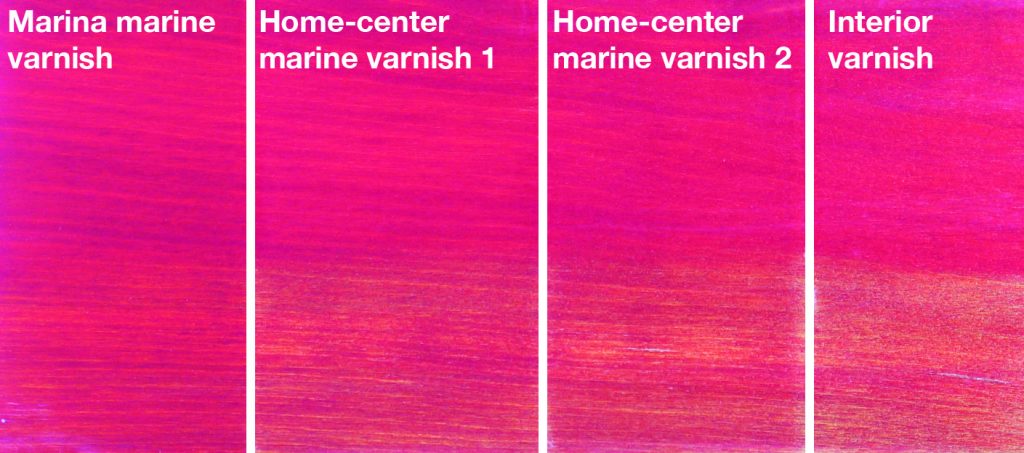
Many exterior finishes claim UV resistance, but there is a big difference in effectiveness. I applied a red dye to this panel, followed by five coats of a marine varnish bought at a marina (left), five coats of two common marine varnishes bought at a home center (center) and five coats of an interior varnish (right). Then I exposed the panel to sunlight for six months with the top half protected by newspaper. The fading of the dye shows that the home-center marine varnishes provided little more resistance to UV light than the interior varnish with no UV absorber.
Here are some supplies and tools we find essential in our everyday work around the shop. We may receive a commission from sales referred by our links; however, we have carefully selected these products for their usefulness and quality.



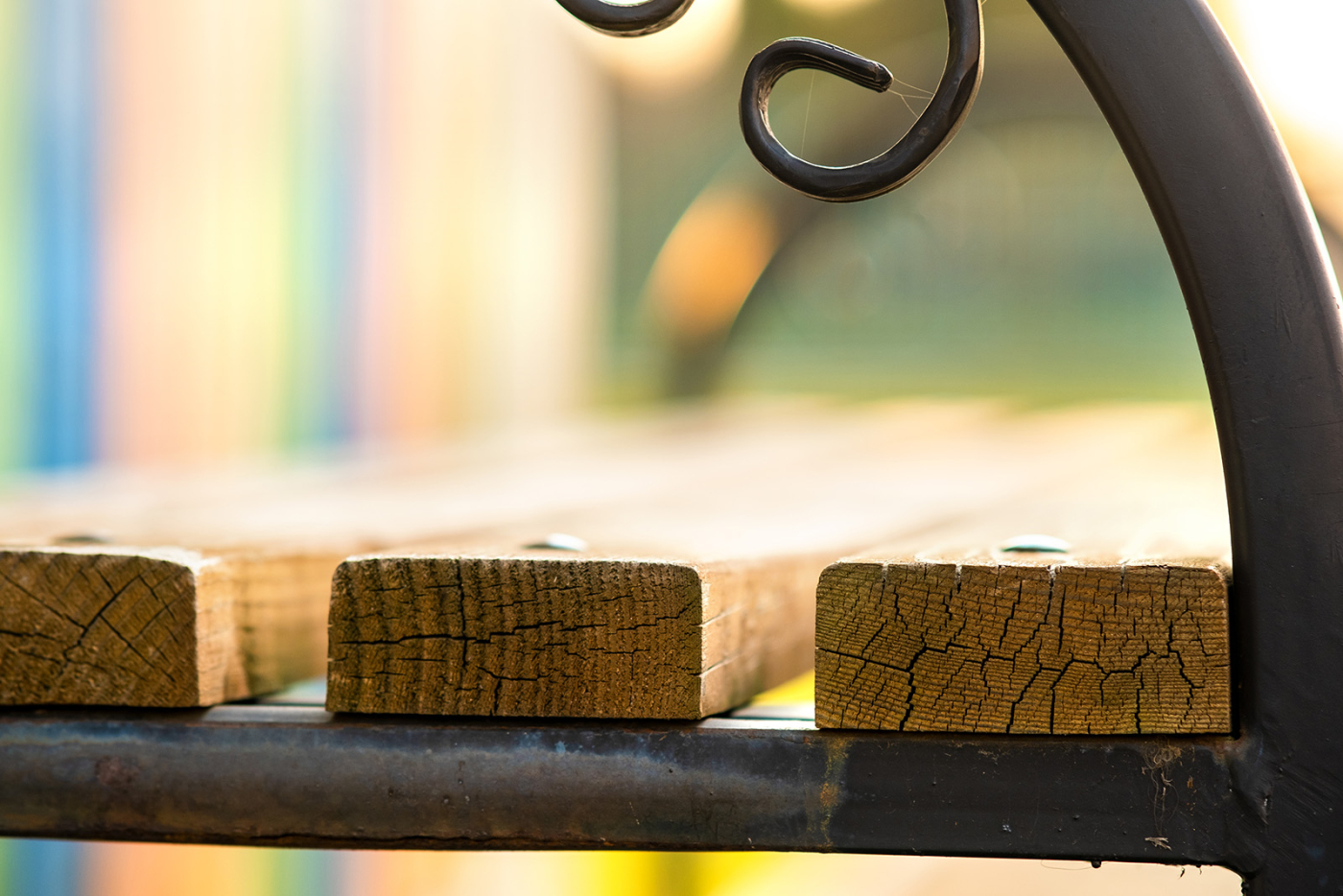 Five different types of protection exist. Here’s a guide to choosing the best one for your project.
Five different types of protection exist. Here’s a guide to choosing the best one for your project.




